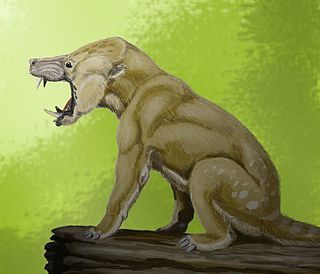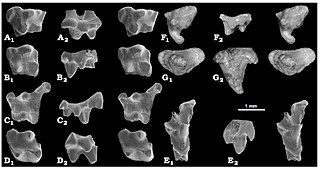
Eutheria, also called Pan-Placentalia, is the clade consisting of placentals and all therian mammals that are more closely related to placentals than to marsupials.

Metatheria is a mammalian clade that includes all mammals more closely related to marsupials than to placentals. First proposed by Thomas Henry Huxley in 1880, it is a more inclusive group than the marsupials; it contains all marsupials as well as many extinct non-marsupial relatives. It is one of two groups placed in the clade Theria alongside Eutheria, which contains the placentals. Remains of metatherians have been found on all of Earths continents.

The Late Cretaceous is the younger of two epochs into which the Cretaceous Period is divided in the geologic time scale. Rock strata from this epoch form the Upper Cretaceous Series. The Cretaceous is named after creta, the Latin word for the white limestone known as chalk. The chalk of northern France and the white cliffs of south-eastern England date from the Cretaceous Period.

Condylarthra is an informal group – previously considered an order – of extinct placental mammals, known primarily from the Paleocene and Eocene epochs. They are considered early, primitive ungulates and is now largely considered to be a wastebasket taxon, having served as a dumping ground for classifying ungulates which had not been clearly established as part of either Perissodactyla or Artiodactyla, being composed thus of several unrelated lineages.

Echinodon is a genus of heterodontosaurid dinosaur that lived during the earliest Cretaceous of southern England and possibly western France in the Berriasian epoch. The first specimens were jaw bones named Echinodon becklesii by Sir Richard Owen in 1861, and since their original description only additional teeth have been discovered. The specific name honours collector Samuel Beckles who discovered the material of Echinodon and many other taxa from across England, while the genus name translates as "prickly tooth" in reference to the dental anatomy of the taxon.

Protungulatum is an extinct genus of eutherian mammals within extinct family Protungulatidae, and is possibly one of the earliest known placental mammals in the fossil record, that lived in North America from the Late Cretaceous to early Paleocene.

Cimolestes is a genus of early eutherians with a full complement of teeth adapted for eating insects and other small animals. Paleontologists have disagreed on its relationship to other mammals, in part because quite different animals were assigned to the genus, making Cimolestes a grade taxon of animals with similar features rather than a genus of closely related ones. Fossils have been found in North America, South America, Europe and Africa. Cimolestes first appeared during the Late Cretaceous of North America. According to some paleontologists, Cimolestes died out at the start of the Paleocene, while others report the genus from the early Eocene.

Vincelestes is an extinct genus of mammal that lived in what is now South America during the Early Cretaceous. It is closely related to modern therian mammals as part of Cladotheria.

Dryolestida is an extinct order of mammals, known from the Jurassic and Cretaceous. They are considered basal members of the clade Cladotheria, close to the ancestry of therian mammals. It is also believed that they developed a fully mammalian jaw and also had the three middle ear bones. Most members of the group, as with most Mesozoic mammals, are only known from fragmentary tooth and jaw remains.

Leptictida is a possibly paraphyletic extinct order of eutherian mammals. Their classification is contentious: according to cladistic studies, they may be (distantly) related to Euarchontoglires, although they are more recently regarded as the first branch to split from basal eutherians. One recent large-scale cladistic analysis of eutherian mammals favored lepictidans as close to the placental crown-clade; and several other recent analyses that included data from Cretaceous non-eutherian mammals found Leptictis to belong to the superorder Afrotheria.

Owenodon is a genus of iguanodontian dinosaur known from a partial lower jaw discovered in Early Cretaceous-age rocks of Dorset, United Kingdom, and possibly also Romania and Spain. The first and only definitive specimen was found in the Lulworth Formation of the Purbeck Limestone Group, dating to the middle Berriasian stage. It was first described by Richard Owen as a species Iguanodon, I. hoggii, honouring naturalist A.J. Hogg who had originally collected the fossil. Owen described the mandible as it was, partially embedded in a limestone block, but it was given to the Natural History Museum, London where it was accessioned as NHMUK PV R 2998 and further prepared. Some damage occurred to a tooth crown and part of the bone while stored in the collections. Redescription of I. hoggii by David Norman and Paul Barrett subsequently transferred the species to Camptosaurus in 2002, as well as tentatively referring other camptosaur-like material from the Purbeck beds to the species. The identity of the species was questioned, with Kenneth Carpenter and Yvonne Wilson, and Greg Paul, separating "C." hoggi from Camptosaurus as an intermediate ornithopod, until Peter Galton named the new genus Owenodon for it in 2009. Galton removed the material assigned by Norman and Barrett from Owenodon, but referred isolated teeth from the Bauxite of Cornet, Romania, and the El Castellar Formation of Spain to O. hoggii. The taxon, believed by Galton to be intermediate between Camptosaurus and Iguanodon, is of uncertain relationships, with the limited material preventing clear understanding of its position within ornithopod evolution. Phylogenetic studies have found Owenodon to be more primitive, equivalent to, or more derived than Camptosaurus, but it is often excluded to improve results.

Acheroraptor is an extinct genus of dromaeosaurid theropod dinosaur known from the latest Maastrichtian Hell Creek Formation of Montana, United States. It contains a single species, Acheroraptor temertyorum. A. temertyorum is one of the two geologically youngest known species of dromaeosaurids, the other being Dakotaraptor steini, which is also known from Hell Creek. A basal cousin of Velociraptor, Acheroraptor is known from upper and lower jaw material.
Oxlestes is an extinct mammal from the Late Cretaceous of Asia, more specifically from the Cenomanian of Uzbekistan. A carnivorous species of uncertain affinities, it is notable for its relatively large size, being among the largest of all Mesozoic mammals. Due to the limited amount of material, it has been considered a nomen dubium.
Ukhaatherium is a now extinct species of mammal that lived during the upper Cretaceous about 84 to 72 million years ago in today's East Asia. It is known above all from the fossil locality Ukhaa Tolgod, Mongolia. An adult Ukhaatherium has an estimated weight of about 32g and bears several similarities to lipotyphlan insectivorans such as the tenrec.
Altacreodus is an extinct genus of eutherian mammals. Fossils have been found in North America where they first appeared during the Late Cretaceous, and they died out prior to the start of the Paleocene. It is possibly one of the earliest known placental mammals in the fossil record.
Zhelestidae is a lineage of extinct eutherian mammals. Occurring in the Late Cretaceous from the Turonian to the Maastrichtian, they were an extremely successful group, with representatives present in Europe, Asia, India, Africa and North America, ostensibly rendering them a cosmopolitan clade. They were specialised towards an herbivorous lifestyle and were in fact initially considered stem-ungulates, but the presence of epipubics and "archaic" dental characters render them as non-placental eutherians.

Zalambdalestidae is a clade of Asian eutherians occurring during the Cretaceous. Once classified as Glires, features like epipubic bones and various cranial elements have identified these animals as outside of Placentalia, representing thus a specialised clade of non-placental eutherians without any living descendants, and potentially rather different from modern placentals in at least reproductive anatomy.
Azilestes is a genus of probable zhelestid eutherian mammal, a family consisting of small herbivores, that was discovered in the early Maastrichtian Grès de Labarre Formation of France. It is a monotypic genus, with only type species A. ragei being known. Only one specimen, the holotype described in 2021, is known. It consists of a partial dentary with teeth.

Gypsonictops is an extinct genus of leptictidan mammals of the family Gypsonictopidae, which was described in 1927 by George Gaylord Simpson. Species in this genus were small mammals and the first representatives of the order Leptictida, that appeared during the Upper Cretaceous.

Holoclemensia is an extinct genus of mammal of uncertain phylogenetic placement. It lived during the Early Cretaceous and its fossil remains were discovered in Texas.

















